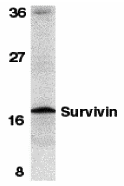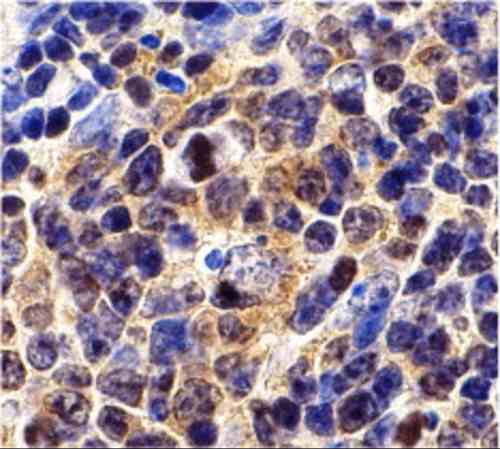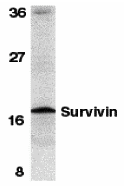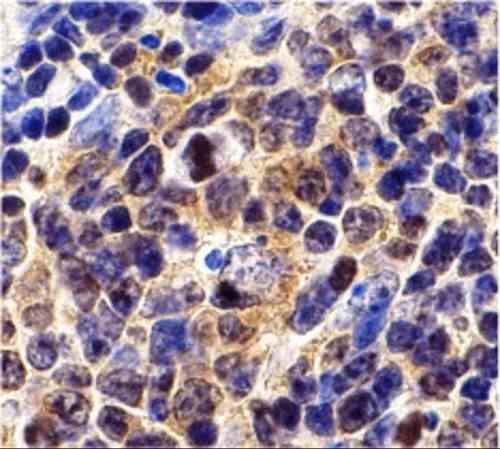| Weight | 1 lbs |
|---|---|
| Dimensions | 9 × 5 × 2 in |
| host | rabbit |
| isotype | IgG |
| clonality | polyclonal |
| concentration | 1 mg/mL |
| applications | ICC/IF, WB |
| reactivity | Survivin (mouse CT) |
| available sizes | 100 µg |
rabbit anti-mSurvivin (CT) polyclonal antibody 8314
$445.00
Antibody summary
- Rabbit polyclonal to mSurvivin (CT)
- Suitable for: ELISA,WB,IHC-P
- Isotype: IgG
- 100 µg
rabbit anti-mSurvivin (CT) polyclonal antibody 8314
| antibody |
|---|
| Tested applications WB,IHC,IHC,ELISA |
| Recommended dilutions Immunoblotting: use at 1ug/mL. Positive control: Mouse spleen cell lysate. Immunohistochemistry: use at 10ug/mL. These are recommended concentrations. Enduser should determine optimal concentrations for their applications. |
| Immunogen Synthetic peptide corresponding to aa 128-140 of mouse Survivin (accession no. BAA28266). |
| Size and concentration 100µg and lot specific |
| Form liquid |
| Storage Instructions This antibody is stable for at least one (1) year at -20°C. Avoid multiple freeze-thaw cycles. |
| Storage buffer PBS, pH 7.4. |
| Purity peptide affinity purification |
| Clonality polyclonal |
| Isotype IgG |
| Compatible secondaries goat anti-rabbit IgG, H&L chain specific, peroxidase conjugated, conjugated polyclonal antibody 9512 goat anti-rabbit IgG, H&L chain specific, biotin conjugated polyclonal antibody 2079 goat anti-rabbit IgG, H&L chain specific, FITC conjugated polyclonal antibody 7863 goat anti-rabbit IgG, H&L chain specific, Cross Absorbed polyclonal antibody 2371 goat anti-rabbit IgG, H&L chain specific, biotin conjugated polyclonal antibody, crossabsorbed 1715 goat anti-rabbit IgG, H&L chain specific, FITC conjugated polyclonal antibody, crossabsorbed 1720 |
| Isotype control Rabbit polyclonal - Isotype Control |
| target relevance |
|---|
| Protein names Baculoviral IAP repeat-containing protein 5 (Apoptosis inhibitor 4) (Apoptosis inhibitor survivin) (TIAP) |
| Gene names Birc5,Birc5 Api4 Iap4 |
| Protein family IAP family |
| Mass 16298Da |
| Function FUNCTION: Multitasking protein that has dual roles in promoting cell proliferation and preventing apoptosis (PubMed:25778398). Component of a chromosome passage protein complex (CPC) which is essential for chromosome alignment and segregation during mitosis and cytokinesis (By similarity). Acts as an important regulator of the localization of this complex; directs CPC movement to different locations from the inner centromere during prometaphase to midbody during cytokinesis and participates in the organization of the center spindle by associating with polymerized microtubules (By similarity). Involved in the recruitment of CPC to centromeres during early mitosis via association with histone H3 phosphorylated at 'Thr-3' (H3pT3) during mitosis (By similarity). The complex with RAN plays a role in mitotic spindle formation by serving as a physical scaffold to help deliver the RAN effector molecule TPX2 to microtubules (By similarity). May counteract a default induction of apoptosis in G2/M phase (By similarity). The acetylated form represses STAT3 transactivation of target gene promoters (By similarity). May play a role in neoplasia. Inhibitor of CASP3 and CASP7 (By similarity). Essential for the maintenance of mitochondrial integrity and function (PubMed:25778398). {ECO:0000250|UniProtKB:O15392, ECO:0000269|PubMed:25778398}. |
| Subellular location SUBCELLULAR LOCATION: Cytoplasm {ECO:0000250|UniProtKB:O15392}. Nucleus {ECO:0000250|UniProtKB:O15392}. Chromosome {ECO:0000250|UniProtKB:O15392}. Chromosome, centromere {ECO:0000250|UniProtKB:O15392}. Cytoplasm, cytoskeleton, spindle {ECO:0000250|UniProtKB:O15392}. Chromosome, centromere, kinetochore {ECO:0000250|UniProtKB:O15392}. Midbody {ECO:0000250|UniProtKB:O15392}. Note=Localizes at the centromeres from prophase to metaphase, at the spindle midzone during anaphase and a the midbody during telophase and cytokinesis. Accumulates in the nucleus upon treatment with leptomycin B (LMB), a XPO1/CRM1 nuclear export inhibitor (By similarity). Localizes on chromosome arms and inner centromeres from prophase through metaphase. Localizes to kinetochores in metaphase, distributes to the midzone microtubules in anaphase and at telophase, localizes exclusively to the midbody. Colocalizes with AURKB at mitotic chromosomes. Acetylation at Lys-129 directs its localization to the nucleus by enhancing homodimerization and thereby inhibiting XPO1/CRM1-mediated nuclear export (By similarity). {ECO:0000250|UniProtKB:E3SCZ8, ECO:0000250|UniProtKB:O15392}. |
| Structure SUBUNIT: Monomer or homodimer. Exists as a homodimer in the apo state and as a monomer in the CPC-bound state. The monomer protects cells against apoptosis more efficiently than the dimer. Only the dimeric form is capable of enhancing tubulin stability in cells. When phosphorylated, interacts with LAMTOR5/HBXIP; the resulting complex binds pro-CASP9, as well as active CASP9, but much less efficiently. Component of the chromosomal passenger complex (CPC) composed of at least BIRC5/survivin, CDCA8/borealin, INCENP, AURKB or AURKC; in the complex forms a triple-helix bundle-based subcomplex with INCENP and CDCA8. Interacts with JTB. Interacts (via BIR domain) with histone H3 phosphorylated at 'Thr-3' (H3pT3). Interacts with EVI5. Interacts with GTP-bound RAN in both the S and M phases of the cell cycle. Interacts with USP9X. Interacts with tubulin. Interacts with BIRC2/c-IAP1. The acetylated form at Lys-129 interacts with STAT3. The monomeric form deacetylated at Lys-129 interacts with XPO1/CRM1. The monomeric form interacts with XIAP/BIRC4. Both the dimeric and monomeric form can interact with DIABLO/SMAC. Interacts with BIRC6/bruce. Interacts with FBXL7; this interaction facilitates the polyubiquitination and subsequent proteasomal degradation of BIRC5 by the SCF(FBXL7) E3 ubiquitin-protein ligase complex (By similarity). {ECO:0000250|UniProtKB:O15392}. |
| Post-translational modification PTM: Ubiquitinated by the Cul9-RING ubiquitin-protein ligase complex, leading to its degradation. Ubiquitination is required for centrosomal targeting. Deubiquitinated by USP35 or USP38; leading to stabilization. {ECO:0000250|UniProtKB:O15392}.; PTM: Acetylation at Lys-129 results in its homodimerization, while deacetylation promotes the formation of monomers which heterodimerize with XPO1/CRM1 which facilitates its nuclear export. The acetylated form represses STAT3 transactivation. The dynamic equilibrium between its acetylation and deacetylation at Lys-129 determines its interaction with XPO1/CRM1, its subsequent subcellular localization, and its ability to inhibit STAT3 transactivation. {ECO:0000250|UniProtKB:O15392}.; PTM: In vitro phosphorylation at Thr-117 by AURKB prevents interaction with INCENP and localization to mitotic chromosomes. Phosphorylation at Thr-48 by CK2 is critical for its mitotic and anti-apoptotic activities. Phosphorylation at Thr-34 by CDK15 is critical for its anti-apoptotic activity. {ECO:0000250|UniProtKB:O15392}. |
| Domain DOMAIN: The BIR repeat is necessary and sufficient for LAMTOR5 binding. {ECO:0000250|UniProtKB:O15392}. |
| Target Relevance information above includes information from UniProt accession: O70201 |
| The UniProt Consortium |
Data
 |
| Western blot analysis of survivin in mouse spleen tissue lysate with survivin antibody at 1 µg/mL. |
 |
| Immunohistochemistry of Survivin in mouse spleen cells with Survivin antibody at 10 ug/mL. |
Publications
| pmid | title | authors | citation |
|---|---|---|---|
| We haven't added any publications to our database yet. | |||
Protocols
| relevant to this product |
|---|
| Western blot IHC ICC |
Documents
| # | SDS | Certificate | |
|---|---|---|---|
| Please enter your product and batch number here to retrieve product datasheet, SDS, and QC information. | |||
Only logged in customers who have purchased this product may leave a review.









Reviews
There are no reviews yet.